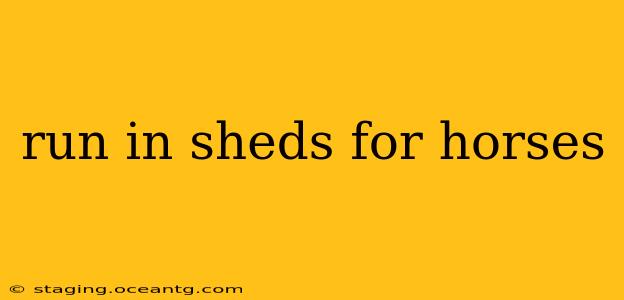Choosing the right shelter for your horse is crucial for their health, comfort, and overall well-being. Run-in sheds offer a perfect balance between protection from the elements and the freedom to roam. This comprehensive guide will explore everything you need to know about run-in sheds for horses, helping you make an informed decision for your equine companion.
What is a Run-in Shed?
A run-in shed, also sometimes called a horse shelter or three-sided shed, provides a partially enclosed structure for horses. Unlike a traditional stable, it typically has three open sides, allowing for ventilation and natural light while offering protection from sun, rain, wind, and snow. This design allows horses to choose their level of shelter, moving in and out as needed.
Why Choose a Run-in Shed for Your Horse?
Run-in sheds offer several advantages over other types of horse shelters:
- Freedom and Natural Behavior: Horses can come and go as they please, mimicking their natural grazing and social behaviors.
- Cost-Effective: Generally less expensive to build or purchase than a fully enclosed stable.
- Easy Maintenance: Requires less cleaning and upkeep than a traditional barn.
- Improved Ventilation: The open design promotes air circulation, reducing the risk of respiratory problems.
- Adaptable: Can be easily customized to fit your specific needs and budget.
What to Consider When Choosing a Run-in Shed
Several factors should influence your decision when selecting a run-in shed:
- Size: The shed must be large enough to comfortably accommodate your horse(s), allowing them to turn around easily. Consider the size of your horse(s) and whether you plan to house multiple animals.
- Materials: Durability and longevity are key. Common materials include wood, metal, and a combination of both. Consider the climate in your area when choosing materials—wood might require more maintenance in harsh weather.
- Location: The shed should be placed in a well-drained area, providing access to shade and shelter from prevailing winds. Proximity to water and feed sources is also important.
- Roofing: The roof should be sturdy and waterproof, providing adequate protection from rain and snow.
- Flooring: Consider the type of flooring best suited to your climate and soil conditions. Gravel or compacted earth are common choices.
How Much Does a Run-in Shed Cost?
The cost of a run-in shed varies considerably based on size, materials, and features. You can expect to pay anywhere from a few hundred dollars for a simple DIY structure to several thousand dollars for a custom-built, high-quality shed. Consider factors such as labor costs if you are not building it yourself.
What are the Different Types of Run-in Sheds?
Run-in sheds come in a variety of styles and designs, including:
- A-Frame Sheds: Simple, cost-effective, and easy to build.
- Gable Sheds: Offer more headroom and space.
- Lean-to Sheds: Often attached to an existing structure, providing additional shelter.
How to Build a Run-in Shed?
Building your own run-in shed can be a rewarding project, allowing for customization and cost savings. However, it requires careful planning, appropriate tools, and construction skills. Detailed plans and instructions are readily available online and from various building supply companies. Consider seeking professional help if you lack experience.
How Big Should a Run-in Shed Be for One Horse?
A general guideline is to provide at least 12 feet by 12 feet of space for a single horse, allowing ample room for movement and turning. However, larger is always better, especially in colder climates where horses may spend more time inside.
What is the Best Material for a Horse Run-in Shed?
The best material depends on your budget and climate. Wood offers a natural aesthetic and good insulation, but requires regular maintenance. Metal is durable and low-maintenance but can be susceptible to rust and overheating in hot climates. A combination of both materials can be a good compromise.
How Do I Protect My Run-in Shed From the Elements?
Properly sealing the shed's roof and walls can prevent leaks and water damage. Regular maintenance and repairs are important to keep the shed in good condition. Consider using weather-resistant paint or sealant.
By considering these factors and investing in a well-designed and constructed run-in shed, you can provide your horse with a safe, comfortable, and enriching environment. Remember, a happy horse is a healthy horse!
